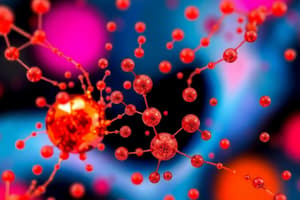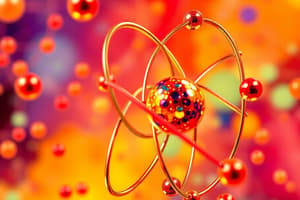Podcast
Questions and Answers
Why do materials characterization?
Why do materials characterization?
- To learn about a material and its properties (correct)
- To destroy materials
- To ignore the material composition
- To forget the material structure
What is the main advantage of using imaging techniques in materials characterization?
What is the main advantage of using imaging techniques in materials characterization?
- To determine the chemical composition
- To study the surface properties
- To analyze the thermal properties
- To visualize the material structure (correct)
What is the purpose of competitive analysis in materials characterization?
What is the purpose of competitive analysis in materials characterization?
- To identify the material composition
- To develop a reference library
- To compare materials properties (correct)
- To analyze the material failure
What type of information does XRD provide in materials characterization?
What type of information does XRD provide in materials characterization?
What is the main application of FTIR in materials characterization?
What is the main application of FTIR in materials characterization?
What is the importance of grain boundaries in materials characterization?
What is the importance of grain boundaries in materials characterization?
Which of the following is NOT a category of materials characterization techniques?
Which of the following is NOT a category of materials characterization techniques?
What is the main goal of materials characterization?
What is the main goal of materials characterization?
What is the primary purpose of light microscopy?
What is the primary purpose of light microscopy?
What are the two main subsystems of a microscope?
What are the two main subsystems of a microscope?
What is the primary function of the objective lens in a light microscope?
What is the primary function of the objective lens in a light microscope?
What is the purpose of the eyepiece lens in a light microscope?
What is the purpose of the eyepiece lens in a light microscope?
How many main groups of optical elements are used in the imaging system of a light microscope?
How many main groups of optical elements are used in the imaging system of a light microscope?
What is the name of the microscopy technique that uses a specialized lens to visualize the sample?
What is the name of the microscopy technique that uses a specialized lens to visualize the sample?
What is the name of the article referenced in the text?
What is the name of the article referenced in the text?
Why do optical paths in an electron microscope need to be under a vacuum?
Why do optical paths in an electron microscope need to be under a vacuum?
How are electron beams focused in an electron microscope?
How are electron beams focused in an electron microscope?
What is the key difference between elastic and inelastic scattering?
What is the key difference between elastic and inelastic scattering?
What determines the wavelength of a particle like an electron or neutron?
What determines the wavelength of a particle like an electron or neutron?
How are electrons typically produced in an electron microscope?
How are electrons typically produced in an electron microscope?
What is a characteristic of inelastic scattering in electron microscopy?
What is a characteristic of inelastic scattering in electron microscopy?
What is the main difference between DICM and PCM?
What is the main difference between DICM and PCM?
How does the illuminating beam work in DICM?
How does the illuminating beam work in DICM?
What is the purpose of the analyzer in PLM?
What is the purpose of the analyzer in PLM?
What is the main application of PLM?
What is the main application of PLM?
What happens to the two polarized beams in DICM after they traverse the sample?
What happens to the two polarized beams in DICM after they traverse the sample?
What is the relationship between DICM and PCM?
What is the relationship between DICM and PCM?
What is observed in the image created by DICM?
What is observed in the image created by DICM?
What is the main difference between PLM and conventional microscopy?
What is the main difference between PLM and conventional microscopy?
Why can Polarized Light Microscopy (PLM) be used to detect amorphous substances in porous media?
Why can Polarized Light Microscopy (PLM) be used to detect amorphous substances in porous media?
What is the main advantage of electron microscopy over light microscopy?
What is the main advantage of electron microscopy over light microscopy?
What type of microscopy is used to image samples that fluoresce?
What type of microscopy is used to image samples that fluoresce?
What is the main application of Polarized Light Microscopy in material analysis?
What is the main application of Polarized Light Microscopy in material analysis?
What is the key difference between light optics and electron optics?
What is the key difference between light optics and electron optics?
What type of microscopy is used to examine the surface and subsurface of nanostructured systems?
What type of microscopy is used to examine the surface and subsurface of nanostructured systems?
What is the principle of Fluorescence Microscopy?
What is the principle of Fluorescence Microscopy?
What type of samples can be analyzed using Fluorescence Microscopy?
What type of samples can be analyzed using Fluorescence Microscopy?
Flashcards are hidden until you start studying
Study Notes
Materials Characterization
- Materials characterization is essential to understand the composition, structure, and properties of materials
- It helps to:
- Learn about a material's composition and properties
- Understand a process or failure
- Conduct competitive analysis and develop standards
- Learn to use an instrument effectively
- Investigate grain boundaries, brittle failure, stress/strain, and corrosion of metals
Categories of Materials Characterization Techniques
- Imaging (e.g., SEM, TEM)
- Surface (e.g., XPS)
- Structural (e.g., XRD)
- Organic (e.g., FTIR)
- Elemental (e.g., XRF - X-Ray Fluorescence)
Importance of Materials Characterization
- Helps in chemistry, engineering, biology, and material science
- Used in clinical and other areas
Imaging Techniques
Light Microscopy
- Definition: uses visible light to produce an image of the sample
- Types:
- Bright field microscopy (BFM)
- Dark field microscopy (DFM)
- Phase contrast microscopy (PCM)
- Polarized light microscopy (PLM)
- Fluorescence microscopy (FM)
Polarized Light Microscopy (PLM)
- Used to analyze anisotropy of a specimen's optical properties
- Helps identify different phases, grain boundaries, and domains
- Can detect amorphous substances in porous media
- Used to analyze the quality of glass and ceramics
Fluorescence Microscopy (FM)
- Used to image samples that fluoresce
- Examples include biological samples, single molecules, and nanoscale fluorophores
Electron Microscopy
- Uses a beam of electrons to produce an image of the sample
- Has a higher resolution than light microscopy due to the shorter wavelength of accelerated electrons
- Used to examine the surface and subsurface of nanostructured systems
Studying That Suits You
Use AI to generate personalized quizzes and flashcards to suit your learning preferences.




